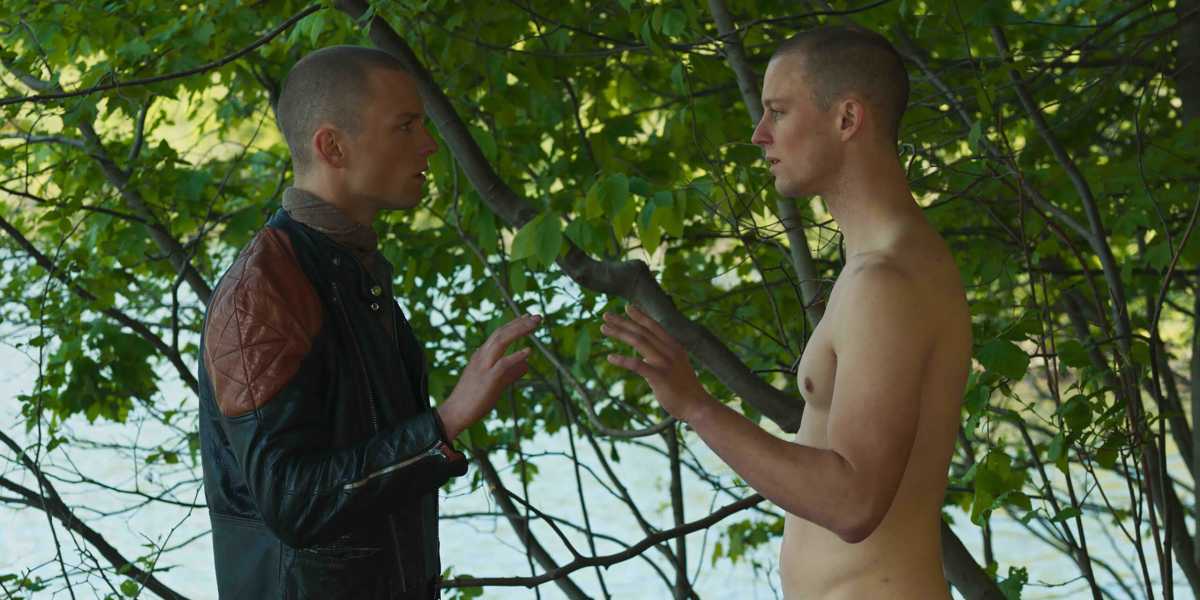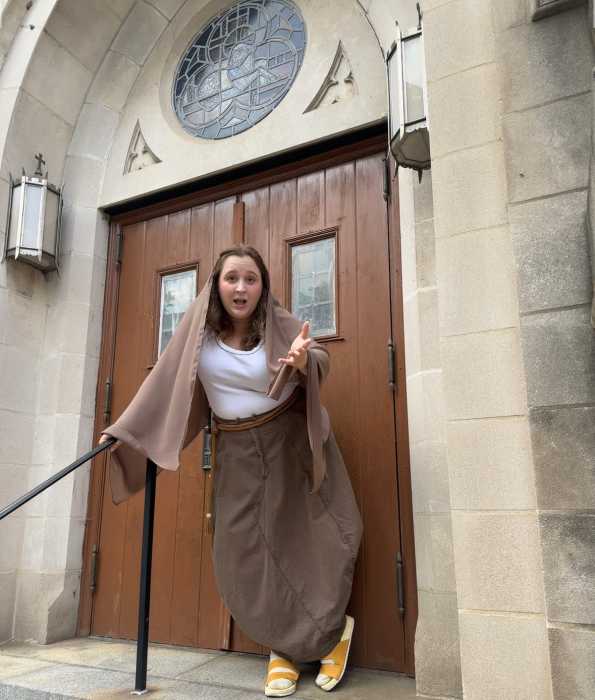Bruce LaBruce’s latest film is a witty comedy about a handsome young man, Dominic (Félix-Antoine Duval) — the opening shot is of his crotch — who goes on a journey of self-discovery (literally!) after his grandmother dies. He arrives at the address where his mother, Beatriz (Tania Kontoyanni) — long thought dead — lives, and in a symbol of rebirth, is naked when he meets her. Their reunion is joyful, but her partner, Irene (Alexandra Petrachuk), is wary of the stranger. Before long, Dominic also discovers he has a twin, Daniel (Duval in a double role), a young monk at a local monastery. Their connection leads to an attraction — and yes, twincest! — but Daniel, is being held as a sex slave by Father Andrew (Andreas Apergis) who worships Saint Sebastian.
“Saint–Narcisse” depicts Dominic as he tries process everything and everyone he confronts. Moreover, his self-love provides much of the film’s humor; Dominic cannot pass by a mirror or see his reflection in a pool of water without admiring himself. Duval gives an unselfconscious performance that exudes eroticism. LaBruce talked with Gay City News about his cheeky romp.
You play with genre as well as content. What inspired this film?
I’ve always been fascinated by twins. I was looking for a story to talk about modern narcissism, and narcissism as the default sensibility in the world. It would be a good opportunity to use twins and narcissism as a metaphor. Also, I’m a huge fan of Québécois 70’s cinema. A lot of these Quebec films from the ’70s address issues like incest and hidden family secrets, and the Catholic angle and guilt about secrets and sexual transgressions that are taboo. That’s why I set the film in the early ’70s and shot in the style of those films.
Your films are often about identity both for individuals and groups. Can you talk about that theme in your work? There are various permutations here — family, brotherhood, parent/child, etc.
The brotherhood of the monks in the film is very homoerotic, and they have their shaved heads so it’s a parallel to the Neo-Nazi skinheads in my earlier film, “Skin Flick.” It’s a bonding brotherhood with homoerotic undertones. Sexuality is part of their masculine bonding. The film is set up as binary. Beatriz’s house and her relationship with Irene — they are identified as witches, which is reference to “The Fox.” She’s the earth mother, wiccan, witchy woman who smokes pot and is hippie-ish, and having sex with a dead lover’s daughter, so that’s a transgressive, incestuous relationship. And then you have Father Andrew in the monastery, a Catholic institution that is rigid and masculine, and he is using some kind of drug to drug the boy and indulge in sadomasochistic sex acts with this boy he’s been grooming. It was about exploring those taboos that are nebulous around incest and symbolic incest.
Dominic admires his reflection and takes his photographs. Can you talk about playing off the myth of Narcissus?
In earlier incarnations of the script I had more direct references, but we cut them out along the way. We had a character based on Echo, and Ameinias, a male lover of Narcissus who killed himself over unrequited love. It’s a very classic myth of narcissism, and a cautionary tale. I still do have the seer, Tiresias, who tells [Dominic], “Don’t know yourself.” I represent Tiresias as a transgender [sex worker] who is blind in one eye. Tiresias is blind, and he also turns into a woman, so she is genderfluid. I was making those connections. I also got the idea of transposing it onto the myth of San Sebastian, who is the patron saint of homosexual suffering and sexy posing. Reinterpreting these myths in a modern context was appealing to me.
The film is sacrilegious — and we would expect nothing less from Bruce LaBruce. Can you talk about how you determined and approached the blasphemous content?
I never really considered it pointedly blasphemous or sacrilegious. I realize that it was inevitably being interpreted that way, but it’s acknowledging that the Catholic church is full of stories of perverted saints who martyr themselves in a sexualized way. I was born in a boring Presbyterian cult, the United Church, which is the most bland and uninspiring religion. Catholicism was for me a glamorous and baroque and sexy religion. I’m exploring the interaction of religious and sexual ecstasy, which are kind of interchangeable.
How did you work with Félix-Antoine Duval on his role and shoot him in double? Did you have him create separate identities?
With Felix, he’s a straight-identified actor in real life, so it was challenging for him on a number of levels. He had three different body doubles. We tried to do it as old school as possible, without using too much CGI—mostly “Parent Trap” special effects/split screen and body double. We had a mixer on location so I could live mix the two halves on screen to make sure eyelines were perfect. We really worked hard on developing two different personalities. Dominic was raised in the city and is more open and optimistic and self-assured, and worldly, and Daniel is morose. He’s been through crazy neglect and abuse and is more introspective and has more vices. He’s sexually corrupt. In terms of body language, we tried to make them distinct.
You feature some very erotic moments in the film, but “Saint–Narcisse” is perhaps tamer than some of your earlier, more explicit work. What can you say about your depiction of sexuality here? It is still bold and daring.
This is the second film I made in Quebec, and it’s financed by Quebec governmental institutions. The first was “Gerontophilia,” which is a companion film because like “Saint–Narcisse,” it is about a taboo and fetish presented in a romantic way and drawing on myths. They are bigger-budgeted films, so I am working within industry context and style, so the idea was to make it less explicit. I was working within an industry model of narrative filmmaking, but also content-wise too. But within that context, I wanted to push the envelope as much as I could and the ideas were more transgressive than the actual explicitness of it. So, the idea of these parallel incestuous relationships between Dominic and Irene are symbolically brother and sister, the twins, the mother and child figures. The implications of transgressing all those taboos is more deceptively radical when you have a film that is a genre film. It’s more interesting to try to include all these transgressive things as subtext or something that is not as blatant as showing something pornographic.
SAINTE-NARCISSE | Directed by Bruce LaBruce | Opening September 17 at the Quad Cinema and via virtual cinemas | Distributed by Film Movement



































